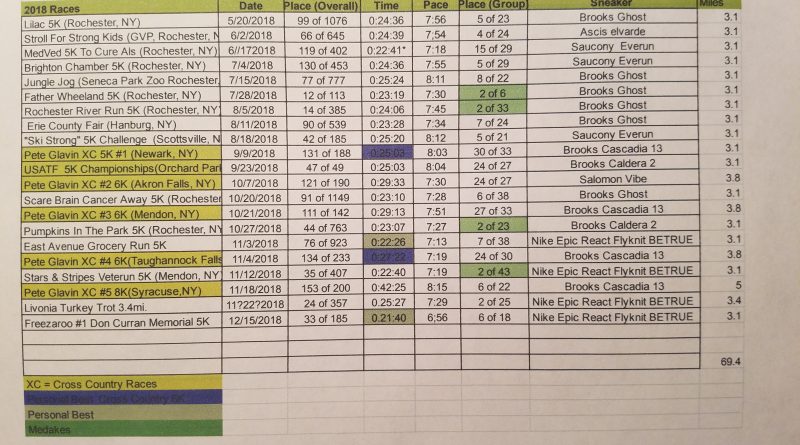My Wildly Successful 2018 Running Life
When it comes to successful racing, there seem to be two types of runners; those who race often, competing in many races a year, thinking about their next race before they have even made it out the finishing chute of the last, and spending most of their training time recovering from races. I fell into this category for the 2018 season. These people essentially race themselves into shape, and truly make the most of racing while they can.
Then there are the others, who fall into this group. Maybe you are an elite, maybe you are injury prone, or maybe you just can only fit a few races into your schedule a year because of other commitments. These are the runners who are very selective with their racing schedule, and only really race when they are ready to chase down some fast times.
There is no right or wrong when it comes to racing…..as long as you are smart with your 5k, 10k, Half-Marathon, or Marathon race day strategy that is!
At the end of the day, all that really matters is that you challenge yourself, have fun (need more of that? Try these extreme and unusual races), and do the best you can with the circumstances you are presented with.
But we often get the question; how far in advance should I plan my races out, and as I am sure you can guess, there are two answers to this question based on which camp you fall into.
Both methods will get you to the same peak race ready to go, and both have their pros and cons (which I will go over). If we say that your goal race is 16 weeks from your starting point, I will explain the various factors that go into each.
I Love to Race
If you like to race often, you probably enjoy the social aspect of racing, and this means that you may be running with friends during a few of your races. If you are doing that, you may not be pushing yourself quite as hard as you would if you were by yourself, or at least not emotionally racing as hard as you would alone as friends tend to keep those demons away a little more.
My success is running “my race” always expecting to do better than my last tace, and usually succeeding.
For that reason, I am probably able to bounce back from races a little quicker than those who race less often. My body also gets used to racing, which helps it understand what is going on. This correlates with what I found in my research about elite warriors and their success despite cramming miles into a weekend.
“ Since I am in the race often group, I do not need to schedule my races as far in advance….. even as I am prepared for the first few races to be ready to go from off-season training and all-year-round racing, as I strive to stay in peak fitness”.
Even as I can swallow my ego and do this, then this method is working best for me.
How to Race Often
Racing often involves just that; within the 30 week stretch from May to November running a race every weekend or two of varying distances (and terrains if my peak race has any hills or turns). I do not taper for any of the races, and will use the races as a workout for the next. Each race should build on the last, and although some will go better than others (and not necessarily in order), my fitness has continued to improve as my peak race closes thus wildly beating my personal record by huge chunks of time.
You may also find that you are able to handle pre-race nerves a little better than if you race less.
In the weeks I am racing, I will be able to do one other race specific workout each week. The race will be my second workout. A long run will depend on the distance I am racing, and the distance of my goal race pace is sognificantly reduced from slogging longer miles thus increasing my VO2 maxx endurance, and strength.
Overcoming Risks for the Race Often Method
I have been fortunate not to get injured and stay healthy, in which I am grateful and thankful for. This race often method can be risky as I am pushing my body very hard, often. But, this risk offers reward to being a faster stronger endurance racer.
I want to race often, then I consider performing both a couple long runs and a couple cross – training workouts at my local health club Midtown Athletic Club each week, High Intensity Interval Training (HIIT) of Body Pump Core Flow, MXT and GRIT strength. That way I am essentially racing,recovering, and pushing for the entire segment. This also involves being very diligent with my recovery, not making these recovery and nutritional mistakes, and listening to my body, even if it means ignoring the pain and running through soreness backing off a class (or backing out of a long run or cutting it to a medium run) if I have any pains that have last more than a few days.
Here’s the deal:
This method also calls for some restraint. If you are a runner who tends to give their all to their racing, in which I am, this method may not be for you as you could end up burned out by the end. Racing to my max not only takes a lot out of me physically, but emotionally too, which does catch up with me by the time I get to the end of seven month of racing season.
This method is best for:
• Runners who enjoy the competitive aspect of racing
• Runners who are good at listening to their body
• Those who are unable to get enough training in during the week due to schedule conflicts
• Runners who enjoy being the best they can be
If You Need to Race Hard, Sparingly
On the other end of the spectrum are those runners who are not as in to racing. These are the runners who enjoy the race specific workouts, and like to have a detailed plan from start to finish.
If you fall into this group, you probably have other commitments (or maybe little ones running around) who determine your schedule weekend to weekend. Either way, racing often is not in the cards for you, and you need to make the most of every opportunity to race.
How to Race Sparingly
“Runners in this group usually like to have a full schedule, knowing their goal pace, and all the workouts in between.”
If I use the week away goal race, I would chose 3-5 races during that 30 weeks. I am likely to race until I am ready to smash my PR , although I should expect to be ready in that first race.
This is where I usually keep an open mind to racing, to limit the amount of pressure I put on myselve since I do race very often.
This works well when I have a few big races in mind, and I love to run them hard. I love to cross that finish line knowing I have given my heart and soul to the race. By racing more often like other running friends, I have less time to emotionally and physically recover between them.
Limited Risks for the Race Sparingly Method
Firstly, be prepared for jealousy. This is one of the issues I personally struggle with being one of these runners, as I see friends with their medals and that post race smile on their faces what seems like every weekend, and you wonder if you should abandon your plan and start over. To use this method I have to be confident in my coach or in my plan, and trust that I am doing the right thing being not as experienced in the sport.
This method requires putting my eggs in one basket. With fewer opportunities to race, you are trusting that you are going to be able to avoid injury and get to that goal race. We never know when we are going to get injured, so it can be difficult to accept if you do have to pull out of your goal race, as you feel like you have gained nothing from the training segment, which of course, is not true! Having fallen victim to this thinking many times!
This method is best for:
• Injury prone runners
• Runners who tend to race to the max every time they race
• Runners who have other commitments/a busy schedule
• Beginner runners
• Runners who like to have a distinct plan (usually Type A personalities!)
“I chose my races carefully. Which group do you fall into”?
What’s the bottom line?
Unfortunately, I am not making this easy on you. There is no right or wrong method for planning out your races to be wildly successful in a goven annual race season, it really depends on what your goals are, and how your body handles training. With either method, you need to make sure you are keeping your easy runs slow enough for your body to recover, which we talked about in our post about running 80% easy leading to 23% faster results.
Racing often, competing in many races a year and spending most of my training time recovering from races. This strategy has made me wildly successful in 2018 season.
I essentially raced myself into shape, and truly made the most of racing while I could by knocking 3:00 minutes off my 5K race time (from 24:40 to 21:40)
This post will give you a few things to consider when you are planning out your next race, but 16 weeks generally the amount of time most people use to prepare for a peak race.
How much you race during that time, is up to you!
Here at Toneman’s Blog, this run experience is first-hand witness to the positive power of perseverance, so I am sharing some of my favorite running blogs with you. I love thei content, and hope it will bring some new ideas and inspiration to keep you moving and motivated!






